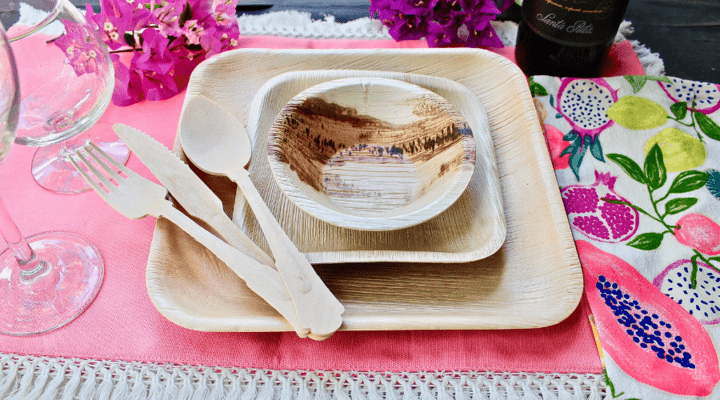


Imagine this: A backyard barbecue, the aroma of grilled burgers fills the air, and laughter echoed through the yard. But the not-so-delightful aftermath comes - a mountain of disposable plates headed straight for the landfill.
Enter the hero of eco-conscious gatherings—biodegradable plates! Are they truly safe for serving your culinary delights, and do they deserve a permanent spot on your sustainable shopping list? Let's grab a plate (a biodegradable one, of course) and dig in!
Biodegradable plates, unlike their flimsy plastic counterparts, offer a delightful surprise. As you pick one up, I give you a satisfying crinkle, a smooth surface confidently cradling your food. These plates come in various textures and designs, some surprisingly sturdy. They're not just safe for the environment but also you!
Here's how:
Reputable manufacturers ensure their plates are free of harmful chemicals like BPA or phthalates, which can sometimes leach from plastics into food, especially when heated. So you can enjoy that steaming hot chili with peace of mind.
Look for certifications like BPI or ASTM D6400 on the packaging. These certifications guarantee the plates are food-safe and won't compromise your health.
While not all biodegradable plates are microwave-safe, some cornstarch options can handle a quick zap. Also, please check the manufacturer's instructions before microwaving.
Biodegradable plates offer a sensory experience that goes beyond safety. The satisfying clink against cutlery creates a more substantial feel than the dull thud of plastic. It's a subtle difference but adds a touch of sophistication that elevates your dining experience.
Traditional plastic plates are the villains in this story. They linger in landfills for centuries, taking up valuable space and potentially leaching harmful chemicals into the environment. Bi-degradable plates offer a robust solution, becoming eco-warriors on your table:
These plates break into harmless organic matter in a proper composting environment. This translates to a significant reduction in landfill burden, freeing up space and preventing chemical leaching.
Unlike petroleum-based plastic plates, biodegradable options are made from renewable resources like corn starch, sugarcane bagasse, or bamboo. This means a smaller carbon footprint and a crucial step towards a more sustainable future.
When composted properly, biodegradable plates transform into nutrient-rich compost, a fantastic addition to your garden! This "garden gold" provides essential plant nutrients, promoting healthy growth and vibrant blooms.
These are just a few ways biodegradable plates can benefit the planet. But the benefits go beyond environmental friendliness!
The world of biodegradable plates is vast, with different materials offering varying benefits. Here's a quick guide to help you choose the right one for your needs:
Cornstarch: Affordable, sturdy, and often microwave-safe.
Sugarcane Bagasse: Eco-friendly, heat-resistant, and known for its attractive natural look.
Bamboo: Superbly durable, sleek, and an excellent choice for a touch of elegance.

Sure, biodegradable plates suit the planet, but what about you, the plate-wielder extraordinaire? Here are some additional benefits to consider:
Gone are the days of flimsy plates that fold under the weight of a juicy burger. Biodegradable plates come in various textures, with some surprisingly sturdy options. This translates to worry-free enjoyment of your food, regardless of weight or temperature.
Some biodegradable plates, like those made from sugarcane bagasse, are heat-resistant, making them perfect for hot meals.
Who says eco-friendly can't be fashionable? Biodegradable plates come in various designs and natural tones, adding a touch of rustic charm to your table setting. Biodegradable plates often come in earthy tones and natural textures, adding a touch of rustic charm to your table setting. Imagine a backyard barbecue with these plates next to a vibrant flower bouquet – a picture of eco-conscious elegance!
Let's face it: disposable plates are convenient. Biodegradable options offer the same convenience without the guilt of plastic waste.
The satisfying clink of biodegradable plates against cutlery creates a more substantial feel than plastic's dull thud. It's a subtle difference but adds a touch of sophistication that elevates your dining experience.
So, you're sold on the environmental benefits of biodegradable plates, but composting might seem daunting. Fear not, eco-warrior! Composting is a surprisingly simple process with fantastic rewards. Here's a sneak peek:
The Composting Crusade Continues: Remember the "garden gold" we mentioned earlier? That's the nutrient-rich compost created from biodegradable plates and other organic materials. This compost provides essential nutrients for your plants, promoting healthy growth and vibrant blooms.
Composting 101: Many municipalities offer composting programs, and numerous online resources guide you through creating your compost bin. The satisfaction of transforming your used plates into garden gold is gratifying!
1. Are biodegradable plates safe for food?
Yes, generally! Lo k for certifications like BPI or ASTM D6400 for food-grade safety.
2. Ca I microwave biodegradable plates?
Maybe! It depends on the material. Also, please check the manufacturer's instructions for microwave use.
3. How long do biodegradable plates take to decompose?
This varies depending on the material and composting conditions, but they typically break down much faster than plastic plates in a proper composting environment.